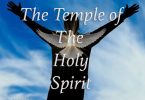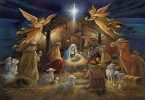
Theme: The Lamb of God who takes away the sins of the world.
Scripture: Is. 49:3.5-6; 1 Cor. 1:1-3; John 1:29-34
We have hardly any seconds to make impression on the people in this fast, innovative, techno-savvy world. Every manufacturer makes great efforts to introduce their product to the people. Today, the authors, the producers of the movies and programs spend thousands of dollars to come up with catchy main title. But when it comes to promotion of their movies or books, the subtitle plays important role. The title of the movie or book makes an impact, catches attention and creates interest among the people but the subtitle does the rest of the work. It explains the specification. If the people don’t get the subtitle, they are not going to take time to read the book or read the synopsis of the movie. The time is precious. Therefore, the subtitle has to hit them hard, fast and clearly. (Key thoughts taken from Smith publicity blog)
John the Baptist had the same task to introduce Jesus to the world. He knew Jesus, the anointed one. He had witnessed him. He also knew the mission of Jesus in this world. He wanted a title for Jesus. The title had to hit them hard, fast and clearly. It should tell them the real identity of Jesus and his mission. John the Baptist choses call Jesus: The Lamb of God. John had many options such as Christ, Lord, Master, Logos, Son of God, Son of Man, Son of David, New Adam, King of the Jews, the Light of the World, Rabbi or Rabboni, Bread from heaven, the way, etc. But he chooses to introduce Jesus with the subtitle, the lamb of God because it summed up all the specifications of Jesus’ character and mission.
To understand the subtitle of lamb of God, we need to understand the Jewish culture and religion. The animal sacrifice was part of Jewish religious worship from the beginning. They believed without shedding of blood, there was no forgiveness of sins (Heb. 9:22). The lamb was important animal of sacrifices for Jews. It symbolized their meekness and innocence before the Lord. The lamb had to be male (kebes), one to three yrs. old and unblemished. They offered lamb every morning and evening (Ex. 29:38). They also offered lamb on the Sabbath day (Num. 28:9), on the feast of new moon (Num. 28:11), on the feast of trumpets (Num. 29:2), on the feast of tabernacle (29:13-40), on the feast of Pentecost (Lev. 23:18-20) and on the day of Passover (Ex. 12:5). Thus, the lamb was sacrificed for the atonement of sins.
John, the Evangelist depicts Jesus’s sacrifice just the way the Hebrews sacrificed lamb in Egypt. They sacrificed lamb to protect themselves from the angel of destruction. They put blood of the lamb on the doorpost with the help of hyssop. They did not break the legs of the lamb. John shows us Jesus also suffered like a lamb. His blood was on the cross. He was offered vinegar with hyssop. They did not break his legs because he was already dead. Thus, Jesus fulfills all the sacrifices of the Old Testament. He replaces them with his own sacrifice.
Now the blood of Jesus saves us. St. Peter will remind us, “You are ransomed, not with perishable things like silver and gold but with the precious blood of Jesus Christ. (1 Pet. 1:18-19) St. Paul will say, “you are consecrated in Christ Jesus” (1 Cor. 1:1-3). The Lamb of God, the subtitle makes us aware of the sacrificial agony and death of Jesus on the cross for our sins. We are reminded at every Eucharist about it. When we sing ‘Agnus Dei’, the priest breaks the Holy Bread (Body of Christ). He raises the broken bread (body of Christ) up and says we are saved by the lamb of God. Let us believe in this great promise of God and turn to Jesus for Salvation.
Fr. Alex D’Mello






